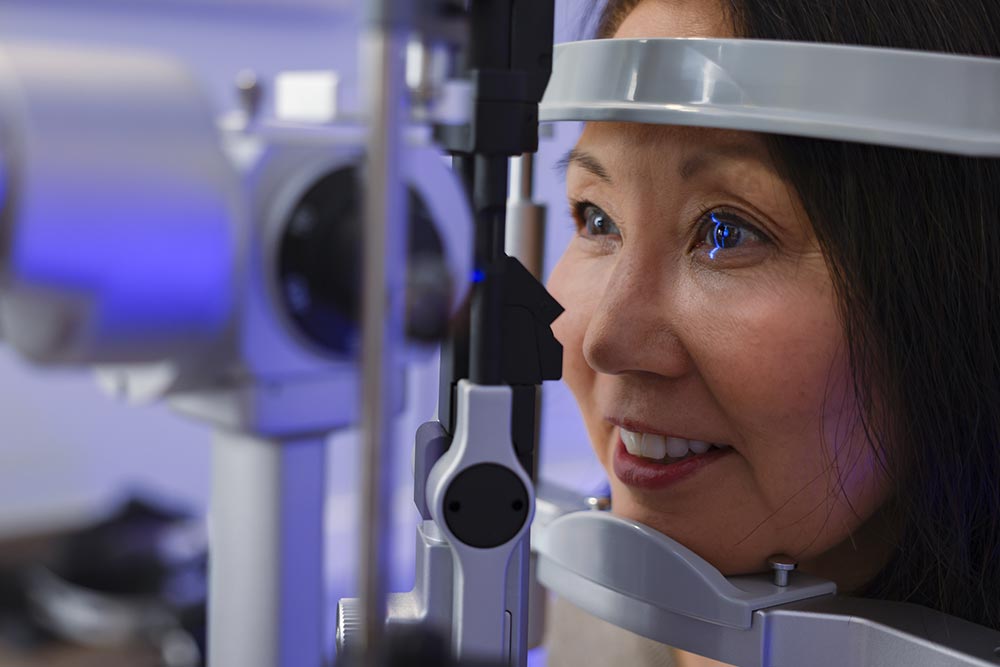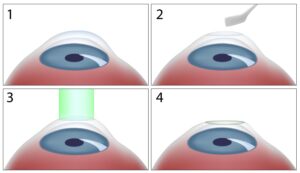Cornea

A healthy cornea is vital for clear and crisp vision. At Azure Eye Center in Ft. Worth, TX, we have extensive experience in diagnosing and treating various cornea conditions to help you see your best.
What is the Cornea?
The cornea is the transparent, dome-like structure at the front of your eye. Besides serving as a barrier to prevent dirt and other particles from entering your eye, it also acts as the window that allows light to enter your eye.
Your cornea is partially responsible for refracting, or bending, the light that enters your eye to help it land directly on the retina, which is located at the back of your eye so you can see. In order to experience clear vision, the light must be able to pass through the cornea easily.
If your cornea is affected by an eye condition that causes it to be cloudy, misshapen, or otherwise irregular, the light will not be able to pass through appropriately, and your vision will be affected.
The cornea is made up of five layers: endothelium, Descemet’s membrane, stroma, Bowman’s layer, and epithelium. There are many eye conditions that can affect the cornea and, thus, your vision.

What Are Common Symptoms of Corneal Conditions?
Symptoms of a corneal condition can vary from person to person, depending on the specific condition. Here are some common signs and symptoms that may indicate what you are experiencing is related to the cornea:
- Pain or discomfort
- Light-sensitivity
- Excess tearing
- Mucus fluid or crusting around your eyes
- Blurred vision
- Redness
The cornea is one of the body’s fastest-healing organs. For this reason, a minor injury to the cornea may make these symptoms short-lasting.
However, a more severe injury or eye condition will prolong and worsen your symptoms. If you notice any of the symptoms above, schedule an appointment with your eye doctor at Azure Eye Center right away. In many cases, early treatment is paramount for ensuring the best vision outcome after treatment.
What is a Pterygium?
A pterygium is a fleshy growth that typically starts on the white inner corners of your eye and gradually grows inward. In some cases, a pterygium can grow so large that it begins to invade the cornea.
What Eye Conditions Affect the Cornea?
There are many eye conditions that affect the cornea. At Azure Eye Center, our cornea specialists have extensive experience diagnosing and treating a variety of corneal conditions.
Here are some of the most common eye conditions to affect the cornea:
Keratoconus is an eye condition that causes progressive weakening of the cornea. Those who have keratoconus, have a cornea that is more cone-shaped rather than the typical spherical shape.
As the condition progresses, the cornea will become weaker, and vision will become more and more blurry or distorted. Many people with keratoconus rely on specialty contact lenses in order to experience clear vision.
If the condition progresses to advanced stages, a corneal transplant may be necessary.
Keratitis is swelling of the cornea. This eye condition can result from a variety of causes, including injury, infection, or contact lens wear.
Keratitis typically causes blurry vision and requires immediate attention to avoid permanent vision loss. To treat keratitis, your eye doctor may recommend medications such as antibiotics.
In Fuchs’ dystrophy, there is a buildup of fluid in the cornea that causes it to swell and thicken. This causes a variety of issues, including blurry vision.
Typically, Fuchs’ dystrophy occurs in both eyes and progresses over the years. This eye condition requires treatment to prevent further vision loss and to improve the health of the cornea.
To treat Fuchs’ dystrophy, your eye doctor may recommend medications or a corneal transplant.
Corneal scarring can develop for numerous reasons, including injury, infections, and certain eye conditions. A corneal scar is an opacity of irregularity on the surface of the cornea.
Corneal scars can vary in size and severity. Corneal scarring can limit the cornea’s ability to allow light to pass through, which can cause significant loss of vision depending on the size of the scar.
To combat the visual symptoms of corneal scarring, you may need to wear specialty contact lenses. In some cases of advanced corneal scarring, a corneal transplant may be necessary.
How Are Cornea Conditions Treated?
There are many eye conditions that affect the cornea. At Azure Eye Center, our cornea specialists have extensive experience diagnosing and treating a variety of corneal conditions.
At Azure Eye Center, our corneal specialists offer a variety of corneal transplant methods, including keratectomy, penetrating keratoplasty, DSAEK, and DMEK.
Keratectomy, also known as superficial keratectomy, is a procedure where your corneal specialist removes the top layer of your cornea, called the epithelium. Often, this is done to smooth out the first layer of the cornea to improve blurry vision.
The keratectomy procedure can help improve vision in those with a variety of eye conditions that affect the cornea. During a keratectomy, your corneal surgeon will use an instrument to remove or smooth out the epithelium of your cornea.
Doing this will allow any tissue causing blurry vision to be exposed.
After removing any damaged tissue, your eye doctor will place a contact lens over your eye that acts as a bandage to allow your cornea to heal.
A penetrating keratoplasty, also known as PKP, is a type of corneal transplant. PKP is a full-thickness corneal transplant, meaning that your entire cornea is removed and replaced with a donor cornea.
Your eye doctor may recommend the keratoplasty procedure if both the front and inner layers of your cornea are damaged and causing vision issues. Due to the extent of the procedure, the recovery period after the keratoplasty procedure is typically longer than other types of corneal transplants.
Although it may take a year or more for you to notice improved vision, a penetrating keratoplasty may be the best option for you to experience clear vision once again, depending on your specific eye condition.
DSAEK, or Descemet’s Stripping Automated Endothelial Keratoplasty, is another type of keratoplasty known as endothelial keratoplasty. Instead of replacing the entire cornea as in PKP, during DSAEK, your corneal surgeon will only replace the innermost layer of the cornea, known as the endothelium, and the next layer, known as Descemet’s membrane.
DSAEK can be an excellent surgical option for those with a corneal condition that causes damage to the endothelium or Descemet’s membrane, such as Fuchs’ dystrophy.
DMEK, or Descemet’s Membrane Endothelial Keratoplasty, is another type of endothelial keratoplasty. The primary difference between DMEK and DSAEK is that the donor tissue used for DMEK is much thinner because it does not include any tissue from the middle layer of the cornea, known as the stroma.
However, since the donor tissue used in DMEK is thinner, recovery is typically shorter than with DSAEK. If you need either DMEK or DSAEK to help improve vision or halt the progression of a corneal condition, your eye doctor will determine which method is best for you.
Do you want to learn more about the cornea or determine if you may be at risk for a corneal condition? Schedule an appointment at Azure Eye Center in Ft. Worth, TX, today!
Request A
Consultation
To request a consultation with Azure Eye Center, please click link below.



